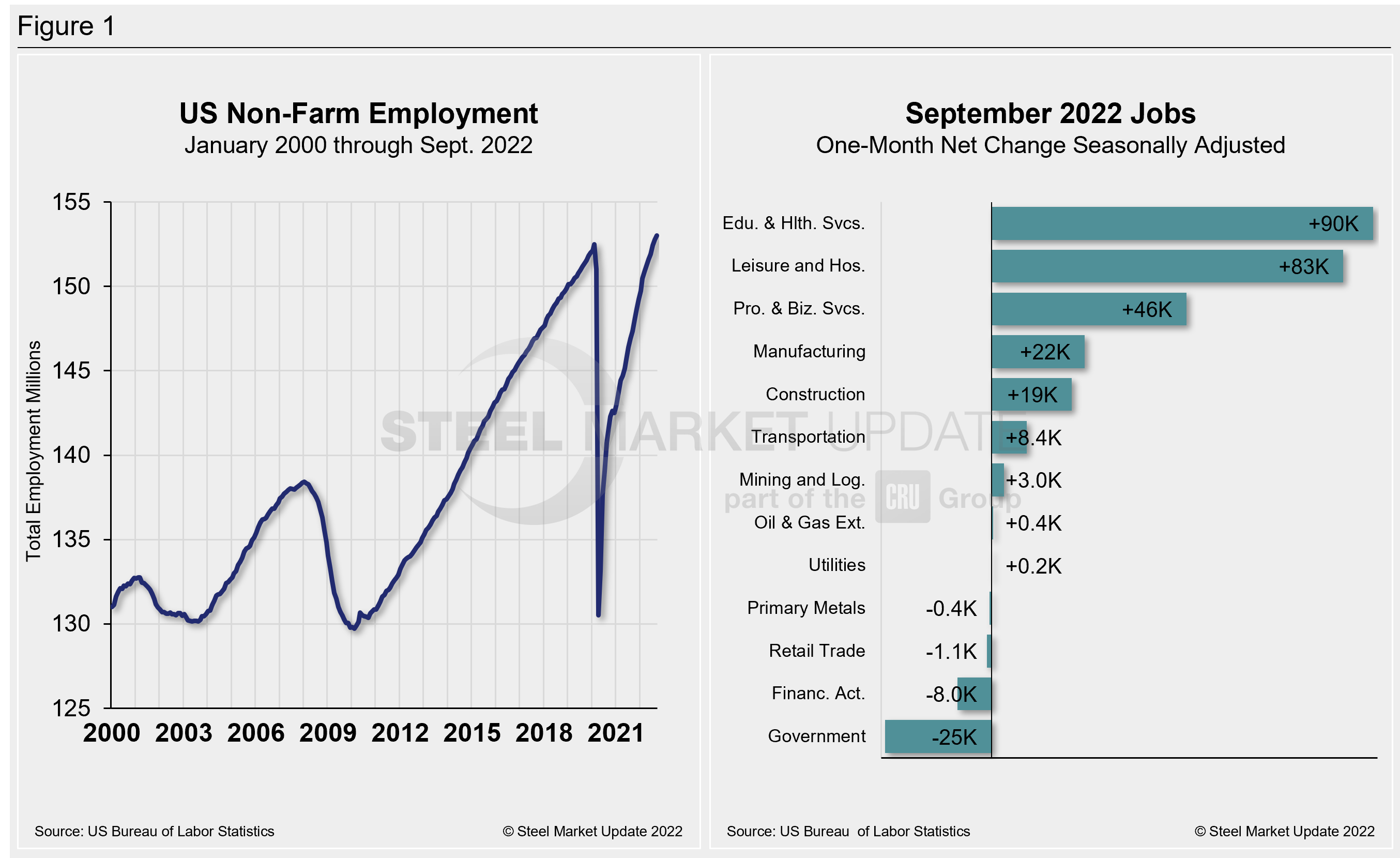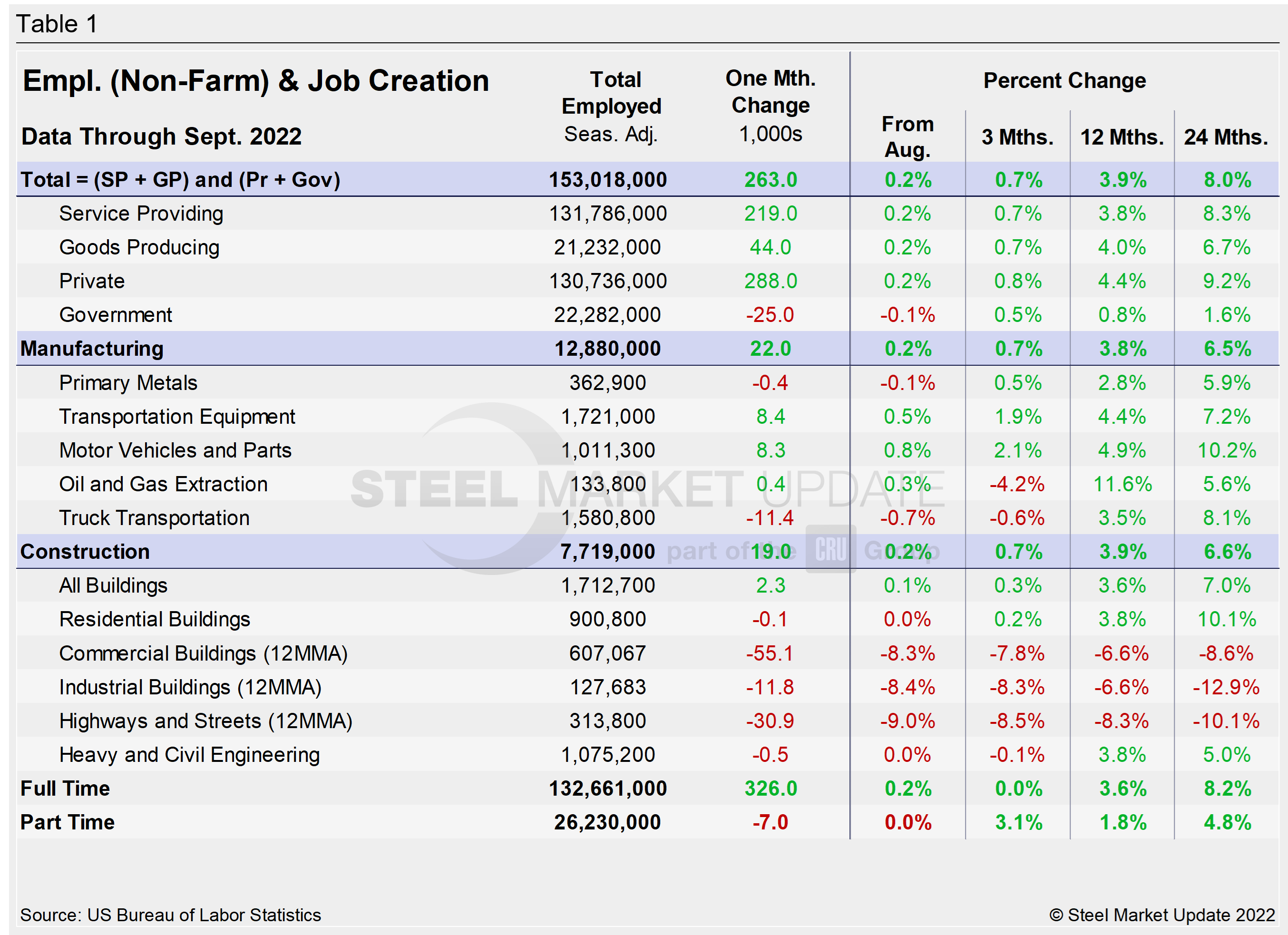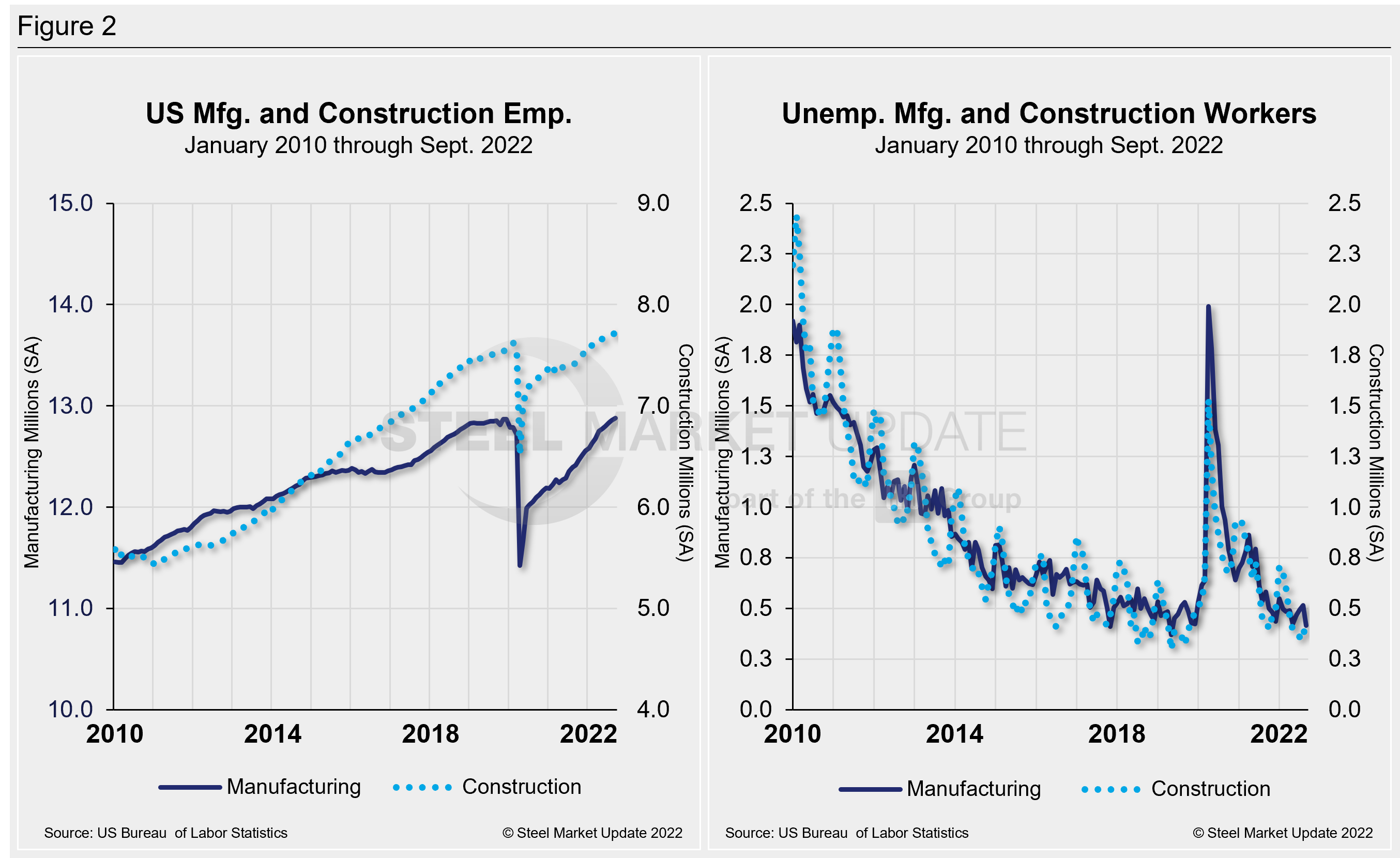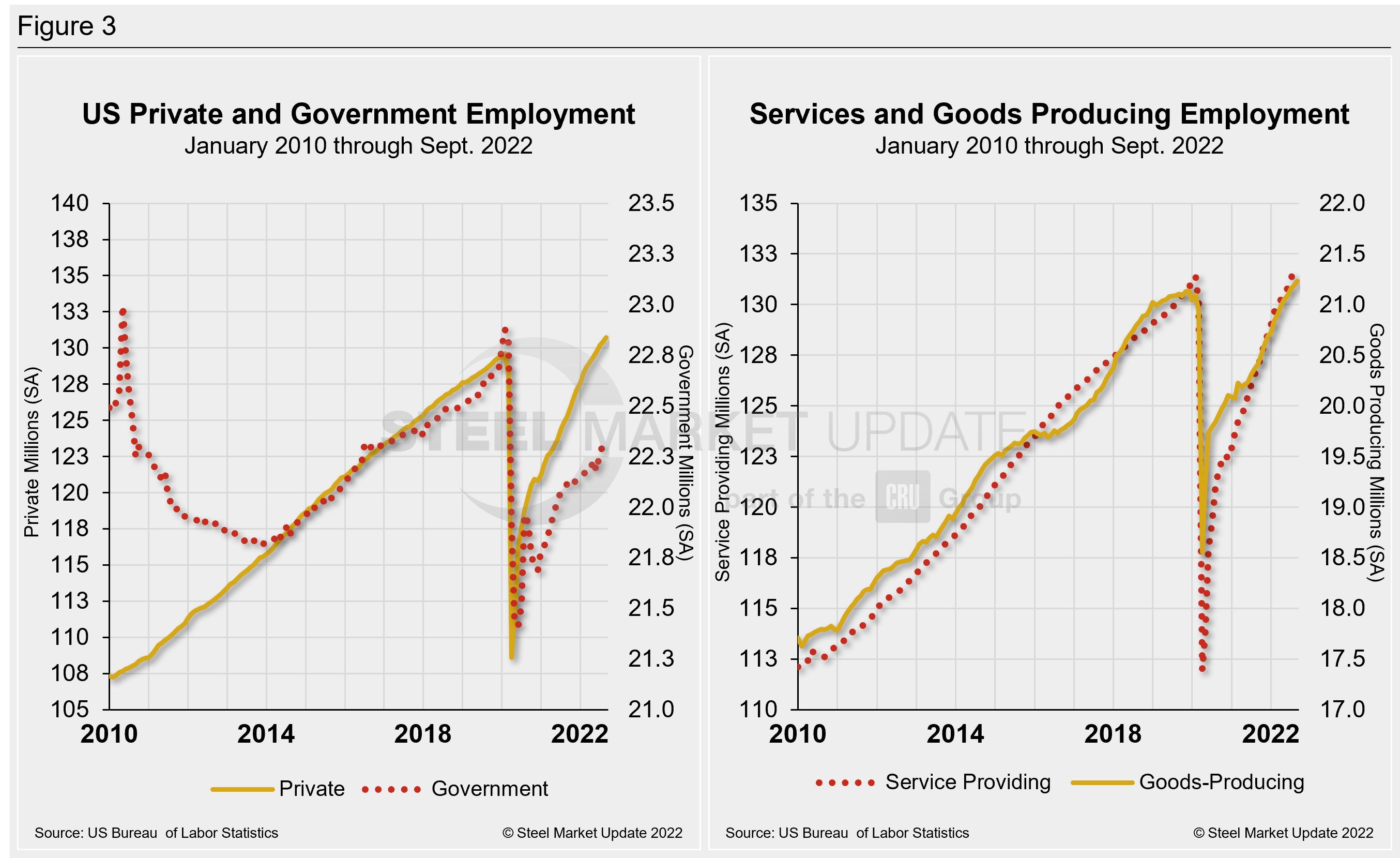Economy

Employment by Industry: Service Sector Top Gainer in September
Written by David Schollaert
October 10, 2022
The US labor market added 263,000 jobs in September, down for the second consecutive month but still better than expected. The result signals that the Federal Reserve will likely have to do more to slow it down.
September was the slowest monthly gain in nearly a year and a half, according to the Bureau of Labor Statistics.
The added payroll gains last month also pushed the unemployment rate back down to 3.5% from 3.7%, matching the pre-pandemic low, and showed another boost in worker wages.
For the past two years, the labor market has been on a tear, recovering quickly from the massive drop-off of 22 million jobs at the onset of the pandemic. The resurgence has come at a rapid pace since. US employers added an average of 562,000 jobs per month last year and 420,000 jobs per month this year, though the rate has been slowing of late and is more in line with pre-pandemic times, according to BLS data.
Job gains last month were widespread with some notable bright spots in the September report. Healthcare employers and leisure and hospitality businesses, which were both battered by the pandemic, continued to add jobs.
The leisure and hospitality sector was again among the standout gainers with 83,000 jobs added in September. The total marks a jump from 31,000 in the prior month but is in line with the average monthly increase over the first eight months of the year. Although the broader labor market has completed its pandemic recovery, employment in the sector remains 1.1 million jobs or 6.7% below the pre-pandemic level.
Payroll gains in healthcare were in line with the February 2020 level, adding 60,000 jobs in September. Professional and business services continued an upward trend last month but climbed at a slower pace, adding 46,000 payrolls last month but about one-third behind to the industry’s 2022 average of 72,000 per month.
Manufacturing jobs rose by 22,000 in September, below this year’s average so far of 36,000 jobs per month. Employment in construction grew by 19,000 on par with the monthly average of around 18,000 in 2022.
Meanwhile, payrolls fell by 8,000 in the transportation and warehousing sector and the financial services sector.
Wages in September continued to rise but were somewhat subdued when compared to the month prior. Average hourly earnings rose 5% on a year-over-year basis last month, down slightly from the 5.2% pace in August. Hourly earnings rose 0.3% monthly, the same as in August.
The labor force participation rate declined by 0.1 percentage point to 62.3%, below the pre-pandemic level of 63.4%.
Shown below in Figure 1 is the total number of people employed in the non-farm economy as well as the month-on-month net change in total jobs in September.

Designed on rolling time periods of one month, three months, one year, and two years, the table below breaks total employment into service industries and goods-producing industries, and then into private and government employees. Most of the goods-producing employees work in manufacturing and construction. Comparing service and goods-producing industries in September shows both increased marginally. The steady and repeated gains have pushed both above pre-pandemic levels, where they’ve been for the past six straight months. Note that the subcomponents of both manufacturing and construction shown in this table do not add up to the total because we have only included those with the most relevance to the steel industry.

Comparing September to August, manufacturing employment was just 0.2% higher, matching the growth seen the month prior. Construction also saw a 0.2% increase MoM, outpacing the 0.1% gain in August. The construction sector is still being driven by the residential market despite strong headwinds. Though homebuilding has slowed, overall commercial and industrial buildings have taken a more notable hit. Heavy and civil engineering, a sector that suffered little during the pandemic, expanded as well and is now nearly a million jobs above where it stood before the last recession.
The three-month and 12-month comparisons show a decent recovery. Primary metals and truck transportation saw job losses last month. The remaining subsectors experienced decent MoM gains.
Manufacturing employment continued to trend up in September, adding 22,000 jobs, marginally below the 27,000 jobs added in August. Construction’s 19,000 payroll gain last month was an improvement from the poor showing in August but still a far cry from the 54,000 added in February and 35,000 added in May.
Construction and manufacturing unemployment both declined in September. Construction unemployment fell 13.7% MoM from 401,000 in August to 346,000 in last month. Manufacturing unemployment was down 19.2% MoM following a 4.9% jump the month prior. Manufacturing unemployment fell from 515,000 in August to 416,000 in September. Both sectors are still being heavily impacted by supply-chain disruptions, labor force constraints, and inflation.
The history of employment and unemployment in manufacturing and construction since January 2010 is shown below side-by-side in Figure 2, seasonally adjusted.

Figure 3 details employment comparisons between private and government jobs, as well as services and goods-producing jobs.

Explanation: On the first or second Friday of each month, the Bureau of Labor Statistics releases the employment data for the previous month. Data is available at www.bls.gov. The BLS employment database is a reality check for other economic data streams such as manufacturing and construction. It is easy to drill down into the BLS database to obtain employment data for many subsectors of the economy. The important point about all these data streams is not necessarily the nominal numbers, but the direction in which they are headed.
By David Schollaert, David@SteelMarketUpdate.com

David Schollaert
Read more from David SchollaertLatest in Economy

Steel exports recovered in May but still historically low
US steel exports rose 10% from April to May but remained low compared to recent years. This came just one month after exports fell to the lowest level recorded in nearly five years.

AISI: Raw steel production ticks up near recent high
The volume of raw steel produced by US mills inched higher last week, according to the American Iron and Steel Institute (AISI). After steadily increasing in April and May, domestic mill output stabilized in early June and has remained historically strong since.

Steel groups welcome passage of budget bill
Steel trade groups praised the passage of the Big Beautiful Bill (BBB) in Congress on Thursday.

Industry groups praise Senate for passing tax and budget bill
The Steel Manufacturers Association and the American Iron and Steel Institute applauded the tax provisions included in the Senate's tax and budget reconciliation bill.

Chicago PMI dips 0.1 points in June
The Chicago Purchasing Managers Index (PMI) slipped 0.1 points to 40.4 points, in June.
